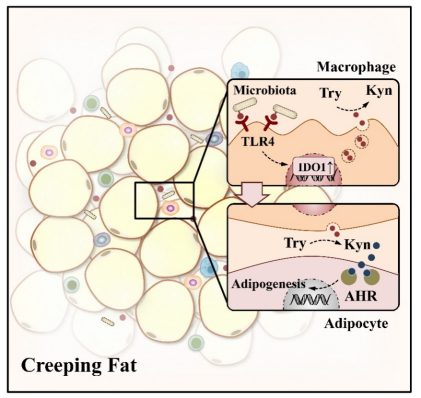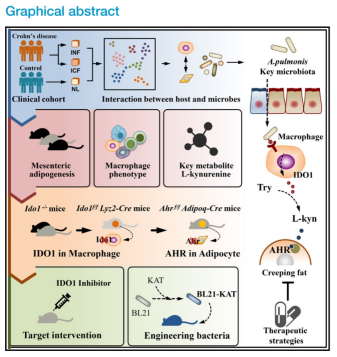Recently, a research titled "Microbiota-induced alteration of kynurenine metabolism in macrophages drives formation of creeping fat in Crohn’s disease," was published online in the Cell Host and Microbe (IF=20.6). This study was led by Professor Ping Lan and Chief Physician Zhen He from the Sixth Affiliated Hospital of Sun Yat-sen University (SYSU). The researchers unveiled a novel mechanism in which alterations of kynurenine metabolism in macrophages, triggered by mesenteric microbiota, played a crucial role in the formation of creeping fat (CrF) in Crohn's disease (CD). This groundbreaking work provides a new therapeutic targets for CrF and a novel insights to improve the prognosis of CD patients.
CD is characterized by its segmental, asymmetric, and chronic penetrating inflammation, primarily involving the terminal ileum and colon. It has become one of the common digestive diseases in China. Most CD patients require long-term medication or even repeated surgical treatment. Hyperplasia and migration of mesenteric adipose tissues, which expands and wraps specifically around sites of intestinal inflammation, is known as CrF. CrF is one of the characterized histopathologic changes in CD patients.
Alteration of the microbial composition and function is one of the crucial mechanisms for the CD development. The team of Ping Lan and Zhen He have been committed to microbial research of CD. Their previous study has demonstrated the role of mesenteric bacteria and their crucial virulence factors in the colitis development by the integration of multi-omics data, endoscopic follow-up, in vivo and in vitro experiments. These findings have been published in the journals Microbiome (IF=13.8) and Advanced science (IF=14.3). Furthermore, their team explore the therapeutic potential of the small molecule compounds and novel probiotics in CD development. These findings have been published in the journals Molecular therapy (IF=12.1) and EBioMedicine (IF=9.7). Although clinical practices have observed that inclusion of the mesentery in ileocolic resection for CD is associated with reduced surgical recurrence, the underlying mechanism how microbiota mediate the formation of CrF remains unclear.
To explore the role of mesenteric microbiota in the formation of CrF, the researches collected the CrF from CD patients for single-nucleus RNA (snRNA) sequencing. This analysis found that the strongest impact of myeloid cells was found on the adipocytes or adipose stem and progenitor cells (ASPCs). Utilizing co-culture system and different mouse models, the researchers demonstrated that the commensal Achromobacter pulmonis (A.pulmonis) induces mesenteric adipogenesis through macrophages alteration.
Subsequently targeted metabolome analysis revealed that L-kynurenine was the most enriched metabolite in CrF. L-kynurenine is converted from tryptophan via the key rate-limiting enzyme indoleamine 2,3-dioxygenase 1 (IDO1). Leveraging single-cell RNA (scRNA) sequencing of mouse mesenteric tissues and macrophage-specific IDO1 knockout mice, the researchers demonstrated that up-regulation of IDO1 in macrophages enhanced the synthesis of L-kynurenine and drove the mesenteric adipogenesis.
Mechanistically, the researchers analyzed the snRNA dataset and established adipocyte-specific aryl hydrocarbon receptors (AHR) knockout mice model. They verified that L-kynurenine from macrophages mediate the mesenteric adipogenesis by AHR in adipocytes. Based on these findings, the researchers further observed that administration of an IDO1 inhibitor or bacteria engineered to degrade L-kynurenine alleviates mesenteric adipogenesis in mice.

In conclusion, the researchers integrated several cutting edge technologies including single-cell RNA sequencing, targeted metabolomics and several animal models in this study. They demonstrated that mesenteric colonization of microbiota mediated mesenteric adipogenesis through an alteration of L-kynurenine metabolism in macrophages and the action of AHR in adipocytes. From the perspective of microbiota, the researchers unveiled a novel mechanism of the CrF formation in CD, providing a new therapeutic targets for CrF and a novel insights for the improvement of the prognosis of CD patients.

This research was supported by National Key R&D Program of China and National Natural Science Foundation of China. Dr. Jinjie Wu from the Department of Colorectal Surgery, Dr. Wanyi Zeng from the Department of Laboratory Medicine, and Dr. Hongyu Xie from the Department of Anesthesiology are co-first authors of the paper.
